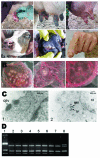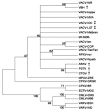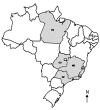Passatempo virus, a vaccinia virus strain, Brazil
- PMID: 16485483
- PMCID: PMC3367646
- DOI: 10.3201/eid1112.050773
Passatempo virus, a vaccinia virus strain, Brazil
Abstract
Passatempo virus was isolated during a zoonotic outbreak. Biologic features and molecular characterization of hemagglutinin, thymidine kinase, and vaccinia growth factor genes suggested a vaccinia virus infection, which strengthens the idea of the reemergence and circulation of vaccinia virus in Brazil. Molecular polymorphisms indicated that Passatempo virus is a different isolate.
Figures







References
-
- Nagasse-Sugahara TK, Kisielius JJ, Ueda-Ito M, Curti SP, Figueiredo CA, Cruz AS, et al. Human vaccinia-like virus outbreaks in Sao Paulo and Goias States, Brazil: virus detection, isolation and identification. Rev Inst Med Trop Sao Paulo. 2004;46:315–22. 10.1590/S0036-46652004000600004 - DOI - PubMed
-
- Morellato PC, Haddad CFB. The Brazilian Atlantic Forest. Biotropica. 2000; 32(4b Atlantic Forest Special Issue):786–92.
Publication types
MeSH terms
LinkOut - more resources
Full Text Sources
Other Literature Sources
